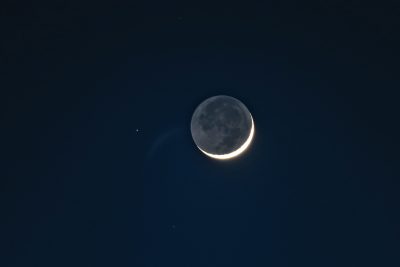I took these from up on the catwalk of the U.S. Naval Observatory Flagstaff Station‘s 61-inch astrometric telescope in Flagstaff, on the evening of 2018-04-17. In all, I got 43 decent exposures, from which I picked four that I liked and that spanned the range of useful twilight brightness. All times are MST. Camera: Canon G3 X.
Images ©Marc A. Murison, CC BY-NC-ND.
Click on an image to enlarge; right-click to view at full resolution in a separate browser tab.
This first image was fairly early, when the Sun was just 6.8 degrees below the horizon (just past the end of civil twilight) and the twilight sky was still bright. Visually, you could just discriminate the reflected Earth light on the dark part of the Moon’s disk from the twilight sky background.
This next exposure was when the Sun was 8.8 degrees below the horizon, about halfway through nautical twilight. Right around this time, the lighting was at its most ethereal and, I think, beautiful. It was a wondrous sight.
This next one is a closeup of just the Moon, showing reflected Earth light from the non-sunlit part of the Moon’s disk. Reflected Earth light is visually striking when the Moon is a thin crescent — look for it the next time you see a thin crescent Moon. The faint arc to the left of the Moon is an internal camera lens reflection from the bright, sunlit sliver. The star on the left is 5 Tau, magnitude 4.1. The fainter one below-left is HD 21379, magnitude 6.25. The stars appear as short trails, and the features of the Moon are blurred, due to the Earth’s rotation during the 2 seconds that the camera shutter was open.
This final image shows the sky when the Sun was 11.8 degrees below the horizon — just before the end of nautical twilight and the beginning of astronomical twilight. The end of astronomical twilight, when the Sun is 18 degrees below the horizon, is when the sky is typically dark enough for astronomers to begin observing. Although you can still see a faint twilight glow near the western horizon even at the end of astronomical twilight, the sky is bright enough to interfere with observations only close to the horizon — where we almost never point telescopes anyway. (The usual rule-of-thumb limit is 30 degrees above the horizon. Lower than that, and you’re looking through too much of the Earth’s turbulent atmosphere for most types of observations to be scientifically useful.)





Do you mind if I quote a few of your posts as long as I provide credit and sources back to your blog?
My blog is in the very same niche as yours and my users would truly benefit
from a lot of the information you provide here. Please let me know if this okay with you.
Many thanks!
Sure, no problem!
I’m amazed, I have to admit. Rarely do I encounter a blog that’s both
educative and entertaining, and without a doubt, you’ve hit the nail on the head.
The problem is something which too few people are speaking intelligently about.
Now i’m very happy I stumbled across this during my search for something relating to this.
Hi there mates, its wonderful paragraph regarding teachingand entirely explained, keep it up all the time.
Wonderful beat ! I would like to apprentice while you amend your website, how can i subscribe for a blog site?
The account aided me a acceptable deal. I had been tiny bit acquainted of this
your broadcast provided bright clear idea
When I initially left a comment I seem to have clicked on the -Notify me when new comments are added- checkbox and now each time a comment is added I recieve 4 emails with the same comment.
Is there a way you can remove me from that service?
Appreciate it!
I’d like to thank you for the efforts you’ve put in penning this site.
I am hoping to view the same high-grade content by you later on as well.
In fact, your creative writing abilities has encouraged
me to get my own, personal blog now 😉
I am actually pleased to read this webpage posts which carries
tons of valuable facts, thanks for providing such data.
Right now it seems like BlogEngine is the top blogging
platform available right now. (from what I’ve read) Is that what you’re using on your blog?
I’d like to find out more? I’d want to find out some additional information.